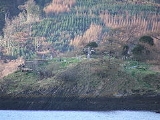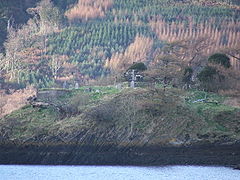
Eilean Munde
Encyclopedia

Loch Leven (Highlands)
Loch Leven 'is a sea loch on the west coast of Scotland. It is spelled Loch Lyon in Timothy Pont's map of the areaand is pronounced Li' un. There is a Leven in Lennox and another in Glen Lyon similarly pronounced...
, close to Ballachulish
Ballachulish
The village of Ballachulish in Lochaber, Highland, Scotland, is centred around former slate quarries. The name Ballachulish was more correctly applied to the area now called North Ballachulish, to the north of Loch Leven, but was usurped for the quarry villages at East Laroch and West Laroch,...
. It is the site of a chapel built by St. Fintan Mundus (also known as Saint Fintan Munnu
Saint Fintan Munnu
Saint Fintán, or Munnu , was the founder and abbot of the abbey at Teach-munnu, today Taghmon in the County Wexford, Ireland.- Life :...
), who travelled here from Iona
Iona
Iona is a small island in the Inner Hebrides off the western coast of Scotland. It was a centre of Irish monasticism for four centuries and is today renowned for its tranquility and natural beauty. It is a popular tourist destination and a place for retreats...
in the 7th Century. The church was burnt in 1495 and rebuilt in the 16th Century. The last service in the church was held in July, 1653. The island is the site of a graveyard once used by the Stewart
Clan Stuart
Clan Stewart is a Highland Scottish clan. The clan is recognised by Court of the Lord Lyon, however it does not have a clan chief recognised by the Lord Lyon King of Arms...
s of Ballachulish, the MacDonalds of Glencoe
Clan MacDonald of Glencoe
The MacDonalds of Glencoe also known as Clann Iain Abrach are a branch of Clan Donald.-History:The founder of the MacDonalds of Glencoe was Iain Fraoch MacDonald The MacDonalds of Glencoe also known as Clann Iain Abrach are a branch of Clan Donald.-History:The founder of the MacDonalds of Glencoe...
and the Cameron
Clan Cameron
Clan Cameron is a West Highland Scottish clan, with one main branch Lochiel, and numerous cadet branches. The Clan Cameron lands are in Lochaber and within their lands is the mountain Ben Nevis which is the highest mountain in the British Isles. The chief of the clan is customarily referred to as...
s of Callart. The clans shared the island and the maintenance of the graveyard, even when there was conflict between them.
Eilean a' Chomhraidh
Near Eilean Munde (or Mhunna) is a smaller island, Eilean a' Chomhraidh (Eilean na Comhairle) or the Isle of Discussion. This was the meeting-place of those persons who had disputes with their neighbours on the land question, and perhaps on other matters besides. When their disputes had been settled satisfactorily the erstwhile disputants sailed up the loch to Eilean na Bainne (about one-and-a-quarter miles west of Kinlochleven). This is the Isle of Covenant or Ratification; here the agreements were drawn up and sealed. Eilean na Bainne is spelled Ylen na Ban in Timothy PontTimothy Pont
Timothy Pont was a Scottish topographer, the first to produce a detailed map of Scotland. Pont's maps are among the earliest surviving to show a European country in minute detail, from an actual survey.-Life:...
's map of the area.
Visit by Robert Forbes
On July 6th 1770, Bishop Robert ForbesRobert Forbes (bishop)
Robert Forbes was the bishop of Ross and Caithness for the Scottish Episcopal Church. He is best remembered for his vocal Jacobite views.-Life:...
sailed up Loch Leven. He records: “We likewise come in view of the Island of St. Munde, who was Abbot and Confessor in Argyll
Argyll
Argyll , archaically Argyle , is a region of western Scotland corresponding with most of the part of ancient Dál Riata that was located on the island of Great Britain, and in a historical context can be used to mean the entire western coast between the Mull of Kintyre and Cape Wrath...
…Upon this island is the ruin of a little chapel, all the four walls of which are still entire, dedicated to the same St. Munde. Though the island has little depth of earth, being rocky, the MacDonalds and Camerons still bury there…”
In a letter to Mr. Stewart of Ballachulish, dated Leith
Leith
-South Leith v. North Leith:Up until the late 16th century Leith , comprised two separate towns on either side of the river....
, Nov. 15, 1770, after giving the history of the saint, as in the text, he proceeds: “As the walls of his chapel with you are still standing, and appear to be entire, I would heartily wish that those who still bury on the island would put a roof upon the chapel. Surely they could do it at a small charge, as there is plenty of wood in the country, and that your slate quarry is at hand. In this case I could have worship in it when God may be pleased to favour me with a return to the delightful Bottom of Ballachelish. I would gladly contribute my mite for patching the walls of the chapel and putting on the roof.”

